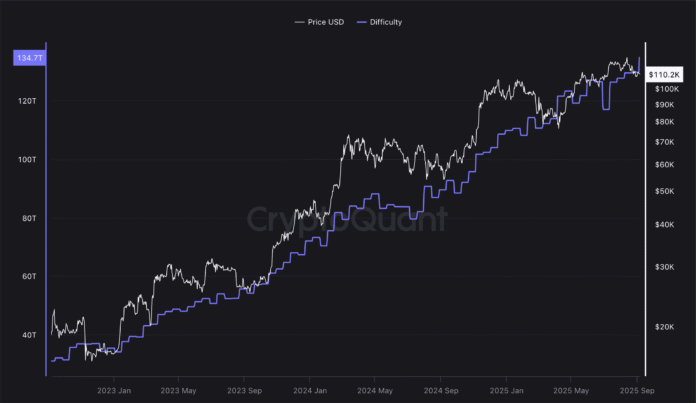Bitcoin Mining Difficulty Reaches New Heights
The Bitcoin (BTC) mining difficulty, which measures the average difficulty level for mining a block on the network, has reached a new all-time high of 134.7 trillion. This milestone was achieved on Friday, surpassing the previous all-time high set in August. Despite projections that network difficulty would decrease, the difficulty level has continued to rise throughout the month.
According to data from CryptoQuant, Bitcoin’s hashrate, which represents the average number of hashes per second from all miners on the network, has fallen to 967 billion hashes per second. This is down from the all-time high of over 1 trillion hashes per second recorded on August 4. The decline in hashrate is likely a result of the increased difficulty level, which requires miners to expend more computing resources to mine blocks on the BTC network.
Bitcoin mining difficulty climbs to new all-time high. Source: CryptoQuant
The increased difficulty level has created tighter operating conditions for large mining firms, which already operate on narrow profit margins. The need to expend more computing resources to mine blocks on the BTC network has also raised concerns over the centralization of Bitcoin mining. As the cost of mining becomes progressively more expensive, it may lead to domination by large corporations and mining pools, potentially undermining the decentralized nature of the Bitcoin network.
Solo Miners Defy the Odds
Despite the challenging environment, small and solo miners are still successfully mining blocks on occasion, claiming the 3.125 BTC block reward valued at over $344,000. In July and August, three solo miners defied the odds by adding blocks to the BTC ledger and claiming the block reward. These miners were operating through the Solo CK pool, a solo mining pool service.
The first solo miner added block 903,883 on July 3, netting just under $350,000 in block subsidy rewards plus priority fees paid by network participants to miners. The second solo miner added block 907,283 on July 26, claiming over $373,000 in rewards. On August 17, another solo miner mined block 910,440, nabbing $373,000 in block subsidy rewards and network fees.
Implications and Concerns
The rise of large mining firms and the increasing difficulty level have raised concerns over the centralization of Bitcoin mining. However, the success of solo miners demonstrates that there is still room for smaller players in the industry. As the Bitcoin network continues to evolve, it is essential to monitor the balance between large and small miners to ensure the decentralized nature of the network is maintained.
For more information on Bitcoin mining and the latest developments in the cryptocurrency space, visit the original source.

